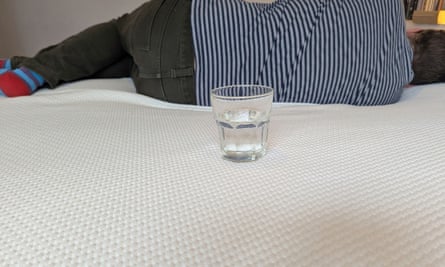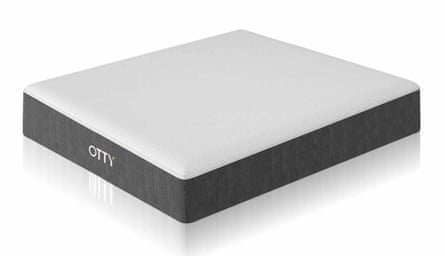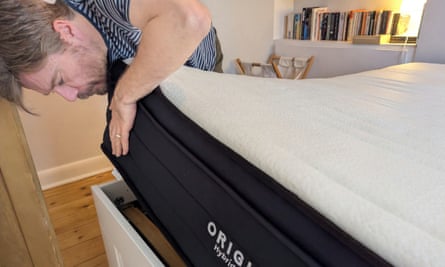A good mattress improves your sleep, say mattress makers – and they would, wouldn’t they? But they’re right. The older I get, the more I know it. When I was 20, I could sleep anywhere: a friend’s floor, a filthy sofa – even a phone box one night. These days I won’t get a single one of 40 winks if I’m not lying on a decent mattress. Comfy but firm, cosy but breathable, and with loads of cool spots for my feet.
Today’s best mattresses promise all this and more. Gone are the days when your biggest decision was between a sprung double or a sprung king size. Pocket springs are still around, but they face stiff – well, medium firm – competition from hybrid mattresses that combine springs and memory foam to provide that all-important balance of comfort and support.
Current in-vogue bed brands tend not to have showrooms, so you can’t normally try out their mattresses before you buy. Instead, they vacuum-shrink them in the factory for delivery straight to your door. These bed-in-a-box mattresses come with long trials, but you’re still buying blind. I’ve tried to shed some light on which are the best by trying them out for you.
I, along with a panel of my family members, tested six bestselling bed-in-a-box mattresses. Among them was a pocket sprung model and five hybrids (which combine memory foam with other materials), covering various degrees of firmness, features and price tags. I’ll test more – including at least one all-foam mattress – in the coming months. Meanwhile, here’s how my family got on with our top picks, including the one my dad gave up on and the one my niece didn’t want to give back.
At a glance
-
Best overall mattress:
Otty Original Hybrid
From £499.99 (single) to £874.99 (emperor) at Otty -
Best mattress for couples:
Simba Hybrid Pro
From £799 (single) to £1,349 (super king) at Simba -
Best budget mattress:
Ikea Valevåg
From £149 (single) to £359 (super king) at Ikea
Why you should trust me
I’ve spent three decades testing products, from mattress toppers to heated clothes airers, so I’m professionally sceptical of manufacturers’ claims to magically improve our lives by buying their stuff. I also have a solid background in napping, insomnia and swearing at alarm clocks, so I welcomed the chance to sleep on the job.
How I tested

First, I needed some sleepers. I wanted a broad range of feedback from people of varying sizes who sleep in various positions. I asked my dad (84), my niece (22), my sister and our husbands to join my mattress panel. We each spent at least a fortnight (and sometimes months) sleeping on an allocated mattress.
Before we divvied them up, my panel assembled to offer their impressions of every mattress on test. We turned our house into a mattress showroom and invited everyone to sit, bounce and lay down on every test sample, alone and together. This enabled us to compare the mattresses side by side and get an overview of their pros and cons. I collected scores out of 10 for everyone’s assessment of firmness and other factors such as breathability, motion isolation and overall comfort, then worked out our average score for each mattress.
We then divided the mattresses and began the sleeping tests. To quantify sleep quality, I used the Pittsburgh Sleep Quality Index, which uses a questionnaire to assess factors such as how long it takes to nod off. I used this as the basis and added questions such as whether they felt back pain or woke up in the night. Some of us also used our smartwatches to gather sleep-tracking stats.

Other factors were easier to test on my own. I used dumbbell weights to measure how far each mattress sank under various weights, while an infrared thermometer and heat pad revealed how fast they could cool under a warm body. A glass of water on the surface gave an idea of how well the mattress would absorb the movement of a restless partner (“motion isolation”).
Environmental credentials were another important consideration. Mattress makers are secretive about the life cycles of their products, but I discovered what I could about the materials used, their manufacture and their potential for recycling. I also checked verified reviews from paying customers and excluded any mattresses for which delivery and customer service received significant negative feedback.
Read on for my guide to the best mattresses, based on these thorough tests.
The mattresses sourced for this article are being donated to two charities: Southampton-based poverty support group Scratch and Hampshire-based survivors’ advocacy organisation Stop Domestic Abuse.
To dive deeper in to my testing process, read how I tested mattresses for comfort, cost and sustainability
The best mattresses you can buy in 2025

Best overall mattress:
Otty Original Hybrid

Otty’s flagship offering is a firm but cosy and supremely comfortable mattress that helped me sleep fantastically from the first night of testing. The only other that managed this was the Simba Hybrid Pro, which is hundreds of pounds more expensive.
Why we love it
The Otty has an outstanding balance of support, cushioning and breathability. My husband and I slept on it for two months and were sad to see it go. It feels ergonomically supportive from edge to edge, with no dip in the middle even after several weeks.
It’s not too hard for comfort, though. As a small side sleeper, I get lower back pain on very firm mattresses, but this didn’t happen with the Otty. My sleep tracker also revealed that I woke up briefly in the night (“microarousals”) less often than usual. The surface felt breathable and cooled down faster than most other hybrids in my heat-retention tests.
When I asked my family to dive in, they put the Otty fourth overall on firmness – squarely at the firm end of the wide medium-firm spectrum – and gave it the highest rating for overall comfort, with an average of 8.3/10.
It’s a shame that … the firmness we loved won’t be welcomed by everyone. If you’re upgrading from a well-used pocket-sprung mattress, the strong flat surface of the Otty may take some adapting to.
Suitable for: anyone who wants to upgrade to a hybrid without forking out four figures
Type: hybrid
Firmness: advertised as medium firm, panel rated as 8/10
Depth: 25cm
Cover: unzip to wash at 40C
Turn or rotate: rotate once a month for first 12 months, then every three months
Trial period: 100 nights
Warranty: 10 years
Old mattress recycling: £40
Sustainability credentials: foam is CertiPUR- and Europur-approved for environmental standards
From £499.99 (single) to £874.99 (emperor) at Otty
Best mattress for couples:
Simba Hybrid Pro

This sumptuous mattress also had me sleeping soundly from the off. It’s expensive, and won’t be firm enough for some, but its wonderfully comfy surface makes you feel like you’re sleeping on a cloud – and it may even bring peace if you share your bed with a fidgety partner (or the dog, or the kids).
Why we love it
The medium-firm Simba Hybrid Pro is supportive enough for most people, but it has a cosy, yielding feel that may be down to its upper layer of natural wool. The overall effect is luxurious and decidedly soporific.
The Hybrid Pro had the best motion isolation in my test. The mattress doesn’t completely lack bounce, especially on a slatted base, but its foam layers absorb movement so well that it genuinely helped me and my husband sleep through each other’s tossing and turning.
Temperature regulation was less impressive, and I wanted to disown my armpits a few times after waking up. The mattress also softened noticeably in the middle after several weeks of testing, but this is common with hybrids and may be welcomed by sleepers who like the way foam adapts to your body over time.
Our panel’s collective firmness score was 7/10 and our comfort average was an excellent 8.1/10, although my husband and sister found it a bit too soft.
It’s a shame that … the price tag is chunky, especially for a mattress that may not maintain its support consistently enough for firm-bed fans.
Suitable for: couples who crave a bit of peace (but still want to share a bed)
Type: hybrid
Firmness: advertised as medium firm, panel rated as 7/10
Depth: 28cm
Cover: unzip to wash at 40C
Turn or rotate: rotate once a month for first three months, then every three months
Trial period: 200 nights
Warranty: 10 years
Old mattress recycling: £50
Sustainability credentials: Simba is B Corp certified and aiming for net zero by 2030. Hybrid Pro foam is CertiPUR approved
From £799 (single) to £1,349 (super king) at Simba
Best budget mattress:
Ikea Valevåg

Ikea’s popular mattress is a bed-in-a-box bargain. It’s not a hybrid but instead wraps its pocket springs in slim layers of polyfoam for cushioning. It feels much less robust than its pricier rivals, but it’d be a great choice for the kids or the spare room.
Why we love it
Simplicity has its benefits. The Valevåg expanded to full size faster than the hybrids and was much lighter. Finally, a mattress I could lift and manoeuvre by myself, including up and down stairs.
For similar reasons, Ikea’s mattress is wonderfully breathable and may feel cooler in summer than a hybrid. With no memory foam to trap heat, it cooled down faster than any other mattress in my temperature-control test. Hi-tech open-cell foam is all very well for letting the air circulate, but plain old springs do the same for a lot less cash.
My 22-year-old niece, Alex, slept on the Valevåg for two months and was energetically reluctant to give it back. She said it felt supportive enough without being “solid like some of the others”.
It’s a shame that … the Valevåg doesn’t hide its cheapness. Our average firmness score was 6.8/10, which barely qualifies for “medium firm” (although Ikea does make a “firm” version). The bounce of the springs also means motion isolation is poor.
Suitable for: young buyers starting out or for a guest room
Type: pocket sprung
Firmness: advertised as medium firm, panel rated as 6.8/10
Depth: 24cm
Cover: not removable
Turn or rotate: not needed
Trial period: 365 nights
Warranty: 10 years
Old mattress recycling: £40 via the Mattress Recycling People
Sustainability credentials: 2025 target of 20% recycled content in all Ikea mattress foams
after newsletter promotion
From £149 (single) to £359 (super king) at Ikea
The best of the rest

Origin Hybrid Pro

Best for: couples who both love a firm orthopaedic mattress
Origin claims its Hybrid Pro is “medium firm” but it is nothing of the sort and instead came top in all my measures of firmness. If, like my sister Maeve and her husband, Ben, you crave the strong pushback of a solid mattress, you will love it. Lucky for them, they got to test it for two months.
This gigantic, heavy hybrid also delivers outstanding temperature regulation and motion isolation. Maeve and Ben reported that the “silky surface with long dents” kept them cool without feeling cold, and after years on a pocket-sprung mattress, they declared its movement-absorbing powers to be “life changing”.
It didn’t make the final cut because … this level of firmness is too hard for many, including me. The 31cm depth also means your standard fitted sheets won’t fit, and the cover isn’t removable.
Type: hybrid; firmness: advertised as medium firm, panel rated as 8.2/10; depth: 31cm; cover: not removable; rotate: not needed; trial: 200 nights; warranty: 15 years; old mattress recycling: £54; sustainability: foam is CertiPUR approved; returned mattresses go to the British Heart Foundation
From £527.45 (single) to £840.95 (super king) at Origin
Eve Wunderflip Premium Hybrid

Best for: couples who like a well-cushioned surface
Eve describes the Wunderflip as a double-sided mattress. It has a solid central section that’s firmer on one side than the other, so you flip it (with a little effort) to select your level of firmness. You then zip on a thick, spongy “comfort layer” – much like a mattress topper – on whichever side you choose.
My weight tests and family feedback revealed the two sides to be disappointingly similar. Both were too soft for Maeve and Ben, who slept on this mattress for a fortnight before switching to the much firmer Origin. Their daughter Alex tried it out and also found it too soft, as did my husband.
I liked the Wunderflip much more than my family did. Its supportive base layers provide strong, consistent pushback beneath the cushioned top layer, especially when you choose the “firmer” side. The foamy cushioning is brilliant at absorbing movement, and it all feels extremely robust.
It didn’t make the final cut because … the “flip for firmness” idea doesn’t really work, because both sides are similarly soft – perhaps because the removable “comfort layer” is so soft. The hulking weight (more than 50kg for a double) makes it tricky to manoeuvre. Better to pick a side and stick with it.
Type: hybrid; firmness: advertised as medium on one side and firm on the other, panel rated as 4.3 and 6.5 respectively; depth: 28cm; cover: not removable; rotate: once a month for first 12 months, then every three months; trial: 200 nights; warranty: 10 years; old mattress recycling: £50; sustainability: foam is CertiPUR approved and CFC/PBDE-free; cover is Oekotex certified
From £499 (double) to £599 (super king) at Eve
Panda Hybrid Bamboo

Best for: larger people who need solid support, and anyone who overheats at night
This fabulous-looking hybrid excels at motion isolation and temperature regulation, and its naturally hypoallergenic bamboo yarn cover may help limit morning sneezes. But it’s a very firm mattress that divided my family on its comfort levels.
I had allocated the Panda to my dad for the sleep test, but he couldn’t get on with it, describing it as “hard on my joints”. It felt too firm for me, too. My husband and brother-in-law – both much taller than my dad and me – loved the solid support, though, and noted that it’s perfect for reading in bed sat up.
It didn’t make the final cut because … it’s too firm for some. The cover is removable, but inconveniently in one big unit, like one big mattress shell.
Type: hybrid; firmness: advertised as medium firm to firm, panel rated as 8/10; depth: 25cm; cover: remove to wash at 30C; rotate: every 6 months; trial: 100 nights; warranty: 10 years; old mattress recycling: free; sustainability: foam is CertiPUR approved; polyester content is made from “recycled ocean bottles”; will recycle old mattress
From £649 (single) to £1,050 (EU emperor) at Panda London

What you need to know
The bed-in-a-box industry is like Deliveroo for mattresses. Instead of packing a takeaway in a plastic box and whizzing it to your door, companies such as Otty, Eve and Simba shrink their mattresses into metres and metres of plastic and deliver them to your home.
Is it necessary? No, but like Deliveroo, it’s convenient. The downside is that you’re left with an awful lot of packaging. I mean, a hideous amount. Your recycling collection may take the huge cardboard boxes, but in most areas (including mine), they won’t take the metres and metres of polyurethane wrapping. You’ll have to take it to a household waste centre – unless you’re redecorating and need a dust sheet.
Bed-in-a-box companies don’t have showrooms, so they let you sleep on your new mattress for months before you have to decide whether to keep it. My experience of these trials has been fairly smooth, with Otty and Emma both collecting mattresses and issuing refunds quickly. However, neither team was directly employed by the brands (only Ikea sent a branded van when delivering), and the Emma team didn’t know what they were collecting.
No delivery teams offered to take away my old mattress. Most brands offer to recycle old mattresses for a fee of about £50, but you have to organise that in addition to ordering your new mattress. It also seems expensive given that my local council’s recycling team collects mattresses for £20.
Bed-in-a-box warranties typically cover 10 years. That’s excellent, but you’ll have to be careful you don’t void your guarantee by, for example, standing on the mattress or using an electric blanket (as foam can soften and even crack under too much heat).
How do I know it’s a good deal?
It’s Black Friday all year round in mattress world. Bed-in-a-box companies seem to regard “sale” prices as the rule rather than the exception, and Simba, Emma and Dormeo have all been sanctioned by the ASA for misleading marketing tactics.
There are genuine deals to be found, however. If you’re looking at a mattress deal and wondering how legit it is, search Pricerunner to see its price history. Free app Anytracker is less quick but delivers richer results, including alerts when your desired mattress meets your desired price.
Jane Hoskyn is a freelance consumer journalist and WFH pioneer with three decades of experience in rearranging bookshelves and “testing” coffee machines while deadlines loom. Her work has made her a low-key expert in all manner of consumables, from sports watches to solar panels. She would always rather be in the woods

.png) 2 months ago
39
2 months ago
39













































